Say Goodbye to Unwanted Eight-Legged Guests!
Not a fan of surprise encounters with creepy crawlers? Whether they’re lurking in the corners, dangling from the ceiling, or building webs where you least expect them, spiders have a way of making themselves right at home—even when they’re not invited! While most are harmless, some can bite, and let’s be honest—no one wants to share their space with a small army of eight-legged roommates. If spiders are overstaying their welcome, we’re here to help!
Contact our amazing team today and reclaim your space—spider, web-worry-free!
Spider Control & Prevention
Spiders may be natural pest controllers, but that doesn’t mean you want them setting up shop in your home or business. Their webs in corners, sudden appearances, and potential for bites make them an unwelcome presence for most homeowners and businesses. While the majority are harmless, certain species can pose risks, and infestations can quickly become a nuisance. Our spider control services target both existing populations and the conditions that attract them, ensuring your property stays comfortable and spider-free year-round.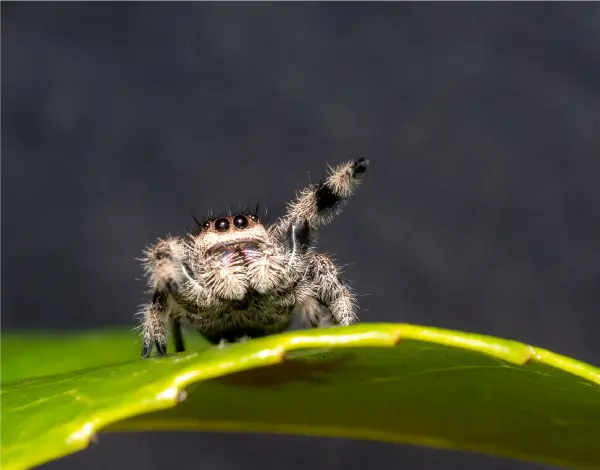 Comprehensive Inspection
Comprehensive Inspection
- Before implementing treatment, our experts perform a thorough inspection to:
- Identify spider harborages inside and outside your home
- Locate areas of high activity, such as corners, crawlspaces, and outdoor lighting
- Assess contributing factors that may be attracting spiders, such as insect populations
Effective Spider Control Treatments – Our multi-step approach includes:
- Web Removal – We brush away webs from accessible areas, disturbing spider populations and increasing their exposure to treatment. Also helping to keep the appearance of your home or business entrance appealing to those welcome visitors.
- Targeted Insecticide Application – We apply residual insecticides to key areas, including the foundation, exterior lighting, eaves, and entry points, to reduce both spiders and their food sources.
Ongoing Prevention & Monitoring
Since spiders thrive where their food supply is abundant, controlling insects around your home is essential for long-term spider prevention. Our recurring pest control services help reduce insect populations, effectively starving out spiders and discouraging them from reestablishing. Our comprehensive spider control program is designed to provide fast relief from existing infestations while ensuring your home or business stays web-free and pest-free year-round.Expert Spider Control Services
Spiders have a way of turning corners into cobwebbed hideouts, making them an unwelcome presence in many homes and businesses. While most are harmless, their webs, sudden appearances, and occasional bites can create discomfort. Our comprehensive spider control solutions use targeted treatments and proactive prevention to keep your home or business spider-free. With routine inspections and ongoing protection, we ensure your space stays comfortable, pest-free, and free of unwanted eight-legged visitors.
- Quarterly & Bi-Monthly Programs
- Target Pests: Ants, spiders and various other crawling insects
-
Service Includes:
- Exterior perimeter inspection and application for crawling insect control
- Removal of accessible wasp nests on the structure of your home
- Sweeping of spider webs followed by an overhead application for spider control
- Interior services as needed
- Quarterly & Bi-Monthly Programs
- Target Pests: Rats, mice, ants, spiders and various other crawling insects.
-
Service Includes:
- Exterior perimeter inspection and application for crawling insect control
- Removal of accessible wasp nests on the structure of your home
- Sweeping of spider webs followed by an overhead application for spider control
- Service exterior rodent bait stations and inspect for potential entry points
- Interior services as needed
- Quarterly & Bi-Monthly Programs.
- Target Pests: Rats & Mice.
-
Service Includes:
- Exterior perimeter inspection for potential entry points, nesting areas or food sources.
- Seal up identified entry points to prevent the rodents from accesses the interior of your home.
- Service exterior and interior rodent bait stations.
- Interior services as needed.
Identification
Giant House Spiders: Big & Bold, But Mostly Harmless
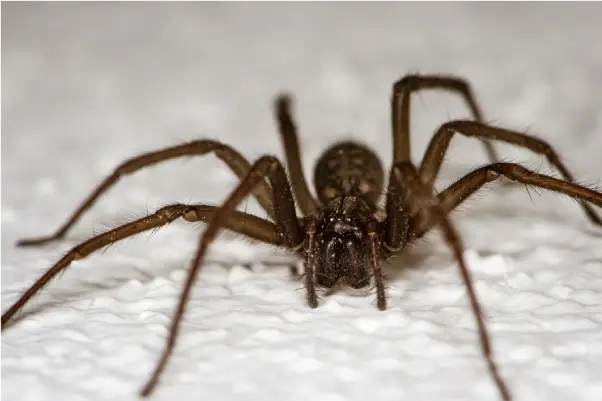 Giant house spiders, much like their hobo spider relatives, can cause quite a scare when they dart across your living room floor. However, despite their large size and fast movements, they are not dangerous to humans and prefer to avoid contact whenever possible.
Giant house spiders, much like their hobo spider relatives, can cause quite a scare when they dart across your living room floor. However, despite their large size and fast movements, they are not dangerous to humans and prefer to avoid contact whenever possible.
These spiders typically live outdoors, but they may move inside if conditions are right. They spin funnel-shaped webs in sheltered areas, using them as both hunting grounds and hiding spots. To reduce the likelihood of giant house spiders setting up inside, it’s best to minimize clutter and stored items around the exterior of your home, eliminating potential harborage areas.
Key Identifying Features:
- Size: Adults can have a leg span of up to 4 inches (10 cm), making them one of the largest spiders in the Pacific Northwest
- Coloration: Varies from dark brown to reddish-brown with subtle markings on the body
- Body Shape: Their cephalothorax (front body segment) is slightly narrower than their large, oval abdomen
- Legs: Long, spindly legs with fine hairs, giving them a slightly fuzzy appearance
- Web Type: Constructs messy, funnel-shaped webs in corners, basements, garages, or outdoor clutter
Where You’ll Find Them:
- Basements, garages, crawl spaces, and sheds – Preferring quiet, undisturbed areas
- Corners of ceilings or walls – Often found in webs waiting for prey
- Under logs, rocks, and outdoor debris – Their natural habitat is outside, but they may venture indoors seeking shelter
- Running across floors – Males are more active in late summer and fall when searching for mates
Daddy Long-Leg Spiders (Cellar Spiders)
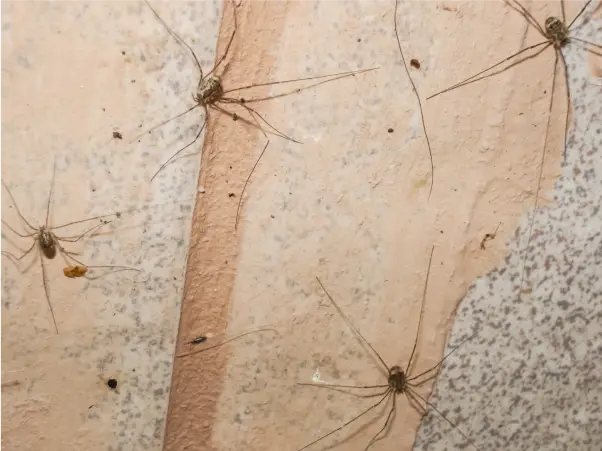 Daddy long-legs spiders (Pholcidae), also known as cellar spiders, are thin-bodied spiders with exceptionally long, delicate legs. Often found hanging upside down in messy webs, they are harmless to humans and feed on small insects, including other spiders.
Daddy long-legs spiders (Pholcidae), also known as cellar spiders, are thin-bodied spiders with exceptionally long, delicate legs. Often found hanging upside down in messy webs, they are harmless to humans and feed on small insects, including other spiders.
How to Identify a Daddy Long-Legs Spider:
- Size: Body length ranges from 0.2 to 0.4 inches (5-10 mm), with legs extending much longer
- Coloration: Pale tan, gray, or light brown with a semi-translucent body
- Body Shape: Small, oval-shaped body with long, thin legs
- Web Type: Loose, irregular webs found in corners, ceilings, and undisturbed areas
- Movement: Shaky, erratic movements when disturbed—they vibrate their web to deter predators
Where You’ll Find Them:
- Basements, attics, garages, and crawl spaces – Preferring dark, humid areas
- Ceiling corners and behind furniture – Their webs often go unnoticed until they accumulate dust
- Sheds and outbuildings – Found in quiet, sheltered locations
While commonly confused with harvestmen (which are not true spiders), cellar spiders are true arachnids and beneficial in homes by preying on other pests.
Black Widow Spiders: Rare but Recognizable
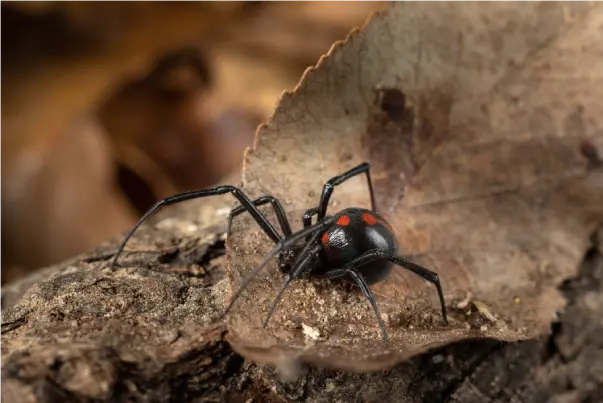 Black widow spiders are more commonly found in Eastern Washington, but they can occasionally be spotted in Western Washington and areas throughout Oregon as well. These venomous spiders are best known for their potentially dangerous bite, though encounters in this region are rare.
Black widow spiders are more commonly found in Eastern Washington, but they can occasionally be spotted in Western Washington and areas throughout Oregon as well. These venomous spiders are best known for their potentially dangerous bite, though encounters in this region are rare.
How to Identify a Black Widow Spider:
- Size: Females are about ½ inch (12-13 mm) in body length, with long, slender legs
- Coloration: Glossy jet black body
- Distinctive Marking: Bright red or orange hourglass shape on the underside of the abdomen
- Web Type: Messy, irregular webs built close to the ground in dark, undisturbed locations
- Behavior: Typically shy and reclusive, preferring to hide rather than confront threats
Where You’ll Find Them:
- Woodpiles, sheds, garages, and crawl spaces – Prefer dark, dry, and sheltered areas
- Under porches, decks, and outdoor furniture – Commonly found in hidden corners
- Basements and storage areas – If indoors, they prefer quiet, undisturbed spaces
While Black Widows are venomous, bites are rarely fatal with proper medical treatment. Their more common lookalike, the False Black Widow (Steatoda species), has a similar dark, rounded body but lacks the red hourglass marking and is not dangerous.
If you believe you have spotted a Black Widow spider on your property, contact us for professional spider identification and control!
Brown Recluse Spiders: Rare & Unestablished in the Pacific Northwest
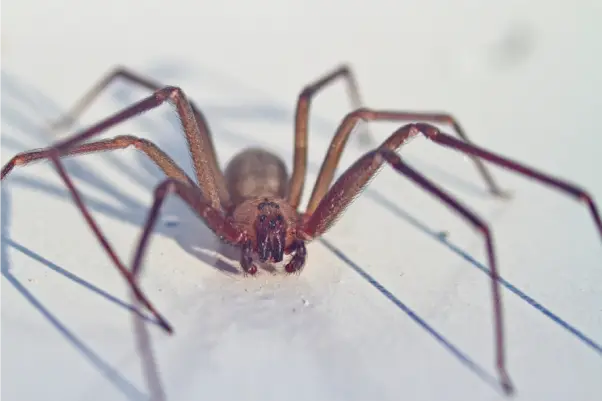 Brown recluse spiders are not native to Washington or Oregon and have not been found to have established populations in these states. Though a few isolated sightings have occurred in Western Washington, these are likely due to hitchhiking on trucks or shipments from the Midwest, where they are primarily found. Brown recluse populations are established in the southern Midwest region of the United States, including states like Missouri, Kansas, and Arkansas.
Brown recluse spiders are not native to Washington or Oregon and have not been found to have established populations in these states. Though a few isolated sightings have occurred in Western Washington, these are likely due to hitchhiking on trucks or shipments from the Midwest, where they are primarily found. Brown recluse populations are established in the southern Midwest region of the United States, including states like Missouri, Kansas, and Arkansas.
How to Identify a Brown Recluse Spider:
- Size: Body length ranges from ¼ to ½ inch (6-12 mm), with long, thin legs
- Coloration: Light to medium brown, sometimes with a slightly darker abdomen
- Distinctive Marking: Dark, violin-shaped marking on the cephalothorax (head region), with the “neck” of the violin pointing toward the abdomen
- Eyes: Unlike most spiders, which have eight eyes, brown recluse spiders have six eyes arranged in three pairs
- Web Type: They are not web-builders like other spiders; instead, they hunt their prey at night and hide in dry, dark spaces during the day
Where Brown Recluses Are Typically Found (Not in WA/OR):
- Attics, basements, and storage areas – Prefer dry, undisturbed environments
- Cardboard boxes, woodpiles, and closets – Common in cluttered spaces where they can hide
- Midwestern and Southern U.S. states – Not established in Washington or Oregon
Are Brown Recluse Bites Dangerous?
Yes, their venom can cause necrotic (tissue-damaging) wounds in some cases. However, not all bites result in severe reactions, and many heal without complications. If you suspect a confirmed brown recluse bite, seek medical attention immediately.
If you are concerned about spider activity in your home or business, contact us for professional identification and control services!
Wolf Spiders: Fast-Moving Hunters, Not Web Builders
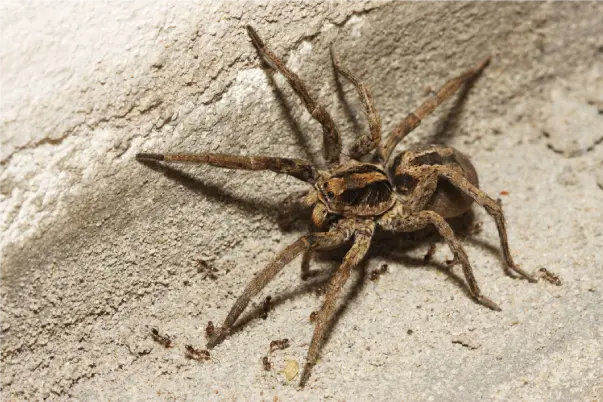 Wolf spiders are common in Washington and Oregon, often found outdoors but occasionally wandering indoors. Unlike many other spider species, they do not spin webs to catch prey—instead, they hunt actively, relying on their speed, agility, and excellent eyesight. While their large size and quick movements can be intimidating, they are not dangerous to humans, and their bites are rarely harmful beyond mild irritation.
Wolf spiders are common in Washington and Oregon, often found outdoors but occasionally wandering indoors. Unlike many other spider species, they do not spin webs to catch prey—instead, they hunt actively, relying on their speed, agility, and excellent eyesight. While their large size and quick movements can be intimidating, they are not dangerous to humans, and their bites are rarely harmful beyond mild irritation.
How to Identify a Wolf Spider:
- Size: Body length varies by species, but adults typically range from ½ to 2 inches (12-50 mm), including legs.
- Coloration: Brown, gray, black, or tan, often with camouflaging mottled or striped patterns
- Body Shape: Stocky and robust with a broad cephalothorax (head region) and abdomen
- Eyes: Eight eyes arranged in three rows, with the middle two being large and prominent, giving them excellent vision
- Legs: Long, sturdy, and covered in fine hairs, allowing them to move quickly
- Web Type: No webs—they chase down prey instead of catching it passively
Where Wolf Spiders Are Commonly Found:
- Outdoors in gardens, under rocks, logs, and leaf litter – Their natural hunting grounds
- Basements, garages, and sheds – Occasionally wander inside but do not establish webs
- Ground-level areas and dark corners – Often seen scurrying along floors or walls when disturbed
Are Wolf Spiders Dangerous?
Despite their intimidating size and quick movements, wolf spiders are not aggressive and only bite if provoked or handled. Their venom is not medically significant, and bites typically result in mild swelling, redness, or itching, similar to a bee sting. If you are seeing more wolf spiders in your home than usual, it could indicate an abundance of other insects attracting them. Contact us for expert spider and pest control solutions!Hobo Spiders: Misunderstood Funnel-Web Builders
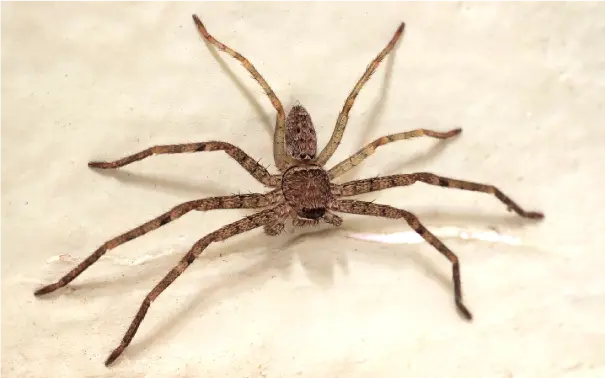 Hobo spiders (Eratigena agrestis) are common in Washington and Oregon, often found in basements, crawlspaces, and outdoor structures. These ground-dwelling spiders build funnel-shaped webs to catch prey rather than actively hunting like wolf spiders. While they were once thought to be dangerous to humans, recent studies suggest that their venom is not medically significant, and they are unlikely to cause necrotic bites as previously believed.
Hobo spiders (Eratigena agrestis) are common in Washington and Oregon, often found in basements, crawlspaces, and outdoor structures. These ground-dwelling spiders build funnel-shaped webs to catch prey rather than actively hunting like wolf spiders. While they were once thought to be dangerous to humans, recent studies suggest that their venom is not medically significant, and they are unlikely to cause necrotic bites as previously believed.
How to Identify a Hobo Spider:
- Size: Adults typically range from ½ to ¾ inch (12-20 mm) in body length, with legs extending beyond
- Coloration: Light to medium brown with no distinct markings on the abdomen
- Body Shape: Oval-shaped abdomen with a slightly elongated cephalothorax (head region)
- Legs: Long and spindly, covered in fine hairs but no noticeable spines
- Eyes: Eight small eyes arranged in two rows, giving them poor eyesight
- Web Type: Funnel-shaped webs built near ground level in corners, basements, crawlspaces, and woodpiles
Where Hobo Spiders Are Commonly Found:
- Basements, crawlspaces, and garages – Prefer dark, undisturbed areas indoors
- Under rocks, logs, and outdoor debris – Thrive in moist, ground-level environments
- Corners of walls and along baseboards – Webs are typically low to the ground
Are Hobo Spiders Dangerous?
- Recent studies indicate that hobo spider venom is not harmful to humans—they are not considered medically significant
- They are not aggressive but may bite if provoked or trapped against the skin
- Bites, if they occur, typically result in mild swelling, redness, and irritation, similar to other common spider bites
If you are seeing an increase in hobo spiders, it may indicate a larger insect population attracting them. Contact us for expert spider control solutions to keep your home or business pest-free!
Risks
The Risks of Spider Infestations
Spiders come in a variety of shapes, sizes, and colors, but no matter the species, they all have eight legs and two body segments—making them easy to recognize (and often unwelcome in homes and businesses). While their creepy appearance can be unsettling, most spiders are harmless and avoid human contact.
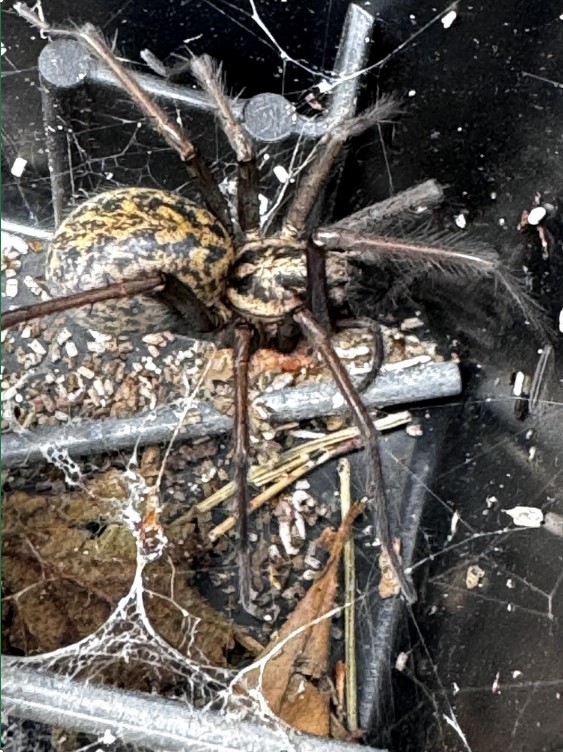 Are Spiders Dangerous?
Are Spiders Dangerous?
- ⚠️ Most Spider Bites Are Accidental – Spiders rarely bite humans unless they feel threatened or trapped (such as when accidentally pressed against the skin).
- ⚠️ Only a Few Have Harmful Bites – While some species have venom that can cause reactions, most spiders in the Pacific Northwest pose no real threat to humans.
- ⚠️ Spiders Help Control Other Pests – Spiders are natural pest controllers, consuming tons of insects and other spiders each year.
Why You Do Not Want Spiders Indoors
Even though spiders play an important role in the ecosystem, their presence inside your home or business can still be problematic:
- Unwanted Webs & Egg Sacs – Many spiders leave messy cobwebs in corners, ceilings, and basements. Some species lay hundreds of eggs at a time, leading to sudden infestations.
- Venomous Spiders (Though Rare) Can Pose Risks – While most local spiders are harmless, black widows and false black widows can sometimes find their way indoors.
- Their Presence Can Indicate Other Pest Issues – Since spiders feed on insects, their activity could signal an underlying pest infestation that needs attention.
Take Control of Your Home or Business—Without the Eight-Legged Guests!
Effective Spider Control Methods
Spider control strategies vary based on property conditions and environmental factors. In many cases, we recommend removing stored items around the perimeter of your home or business—such as woodpiles, ladders, garbage cans, and stacked building materials—as these provide ideal harborage areas for spiders and their prey.
Exterior Spider Control
- Web Removal: We use an extendable Webster brush to sweep away webs, egg sacs, and spider debris from the exterior of your building. This disturbs active spider populations, increasing their exposure to treatment.
- Perimeter Treatment: After web removal, we apply a residual insecticide around key areas, including the foundation, eaves, exterior lighting, window frames, and entry points. This helps eliminate spiders and disrupt their food supply.
Interior Spider Control
- Targeted Treatments: Spiders are drawn to dark, undisturbed areas where they can build webs and feed on other insects. If spiders are making their way inside, we tailor our treatment plan based on your needs, using chemical or non-chemical methods to control activity.
- Harborage Reduction: Decluttering storage spaces such as basements, attics, and closets can help reduce spider-friendly environments inside your home or business.
Ongoing Prevention & Monitoring
Once control has been established, we strongly encourage a recurring preventative service to stop spider populations from reestablishing. Since spiders often return seasonally, especially in our coastal communities, regular treatments help maintain a spider-free environment year-round. Looking for long-term spider control? Contact us today to schedule your customized treatment plan!
Spider Prevention Tips
When you choose our professional spider control services, you are not just getting effective treatment—you’re also gaining valuable insight into how to keep spiders from coming back. Our team will provide expert guidance on simple, proactive steps you can take to help maintain a spider-free home or business between treatments.
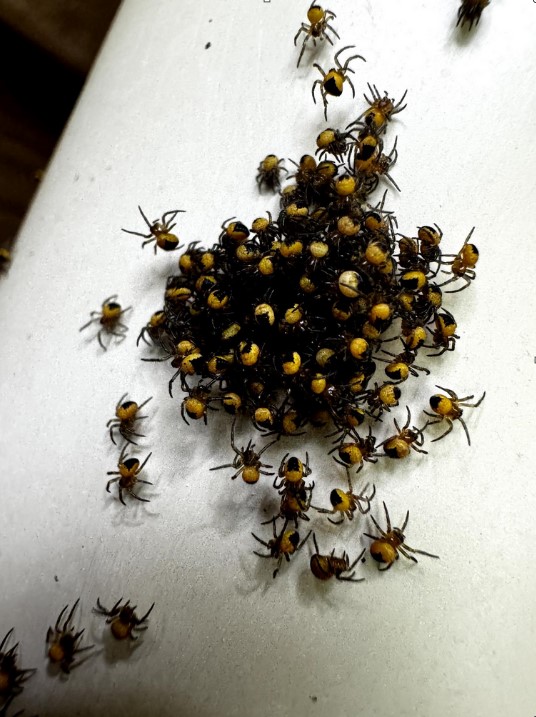 Maintain a Clutter Free Perimeter
Maintain a Clutter Free Perimeter
- Regularly remove clutter and stored items like woodpiles, stacked building materials, garbage cans, and ladders from around the exterior of your property
- Spiders build webs in these sheltered spaces, making it easier for them to move inside
Minimize Indoor Hiding Spots
- Spiders thrive in areas with plenty of cover and an ample food supply
- Declutter storage spaces like basements, attics, and garages to reduce nesting sites
- Regular cleaning, including vacuuming corners, ceilings, and window frames, helps remove existing webs and deters future activity
Trim Vegetation Around Your Home or Business
- Overgrown trees, shrubs, and plants that touch your home or place of business provide natural bridges for ants to enter
- Regularly trimming back vegetation creates a barrier that makes it more difficult for those creepy crawly spiders to access your property
By combining routine spider prevention with professional treatments, you can enjoy a web-free, stress-free home or business year-round. Contact us today to schedule your spider prevention service!

